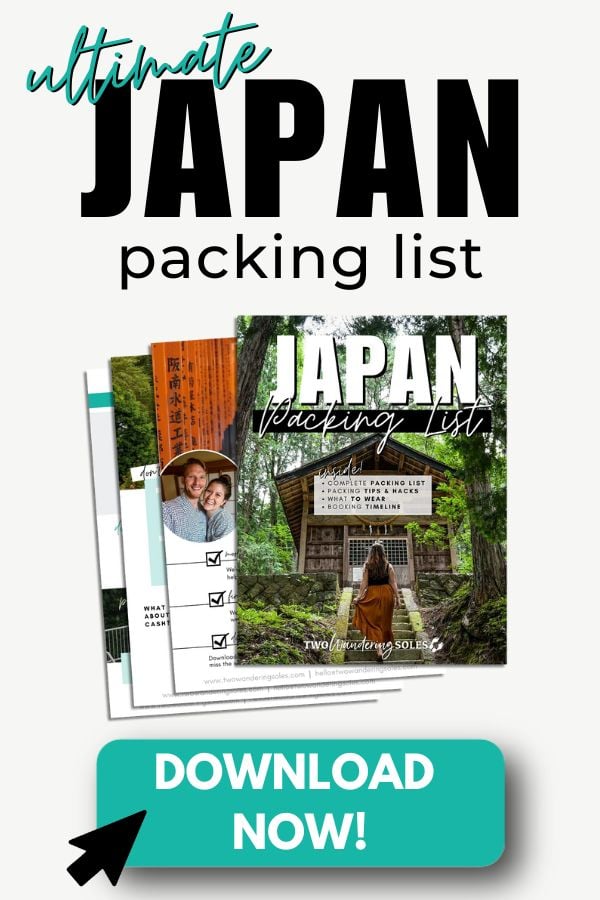The iconic peak of Mount Fuji is without a doubt one of the top sights in Japan and absolutely worth adding to your itinerary. This guide will help you plan the perfect Mount Fuji day trip from Tokyo, including unique experiences and hidden gems.
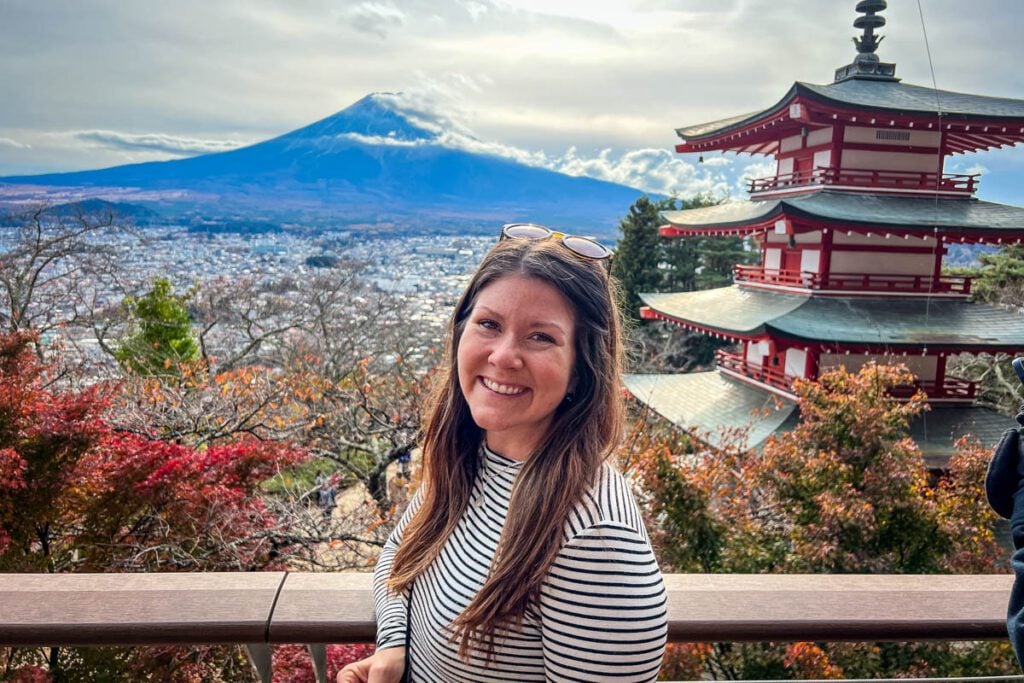
When you think about Japan, the majestic peak of Mount Fuji is probably one of the first images that comes to mind: a near-perfect conical volcano capped with snow and surrounded by stunning landscapes.
Seeing Mount Fuji in all her glory tops many travelers’ Japan bucket lists, and for good reason – this iconic mountain is almost synonymous with Japan and is truly incredible to see in person.
If you don’t have a lot of room in your Japan itinerary, a Mount Fuji day trip from Tokyo is a great way to peep the famous peak.
There are essentially 3 ways to experience Mount Fuji as a day trip from Tokyo:
- Use the Hakone Free Pass
- Self-drive to Kawaguchiko
- Join a guided tour
In this guide, you’ll find itineraries for each of these day trips, including top sights as well as hidden gems.
We’re also sharing some pros and cons for each so you can compare and decide the best day trip to Mount Fuji for your interests and travel style.
Mount Fuji Day Trip Guide
- Why take a day trip to Mount Fuji
- Day trip #1: Hakone Free Pass
- Day trip #2: Self-drive to Kawaguchiko
- Day trip #3: Guided tour from Tokyo
- Mount Fuji facts
- Other things to do nearby
- When to visit
- What to pack
- Mount Fuji FAQs
Why should you take a day trip to Mount Fuji?
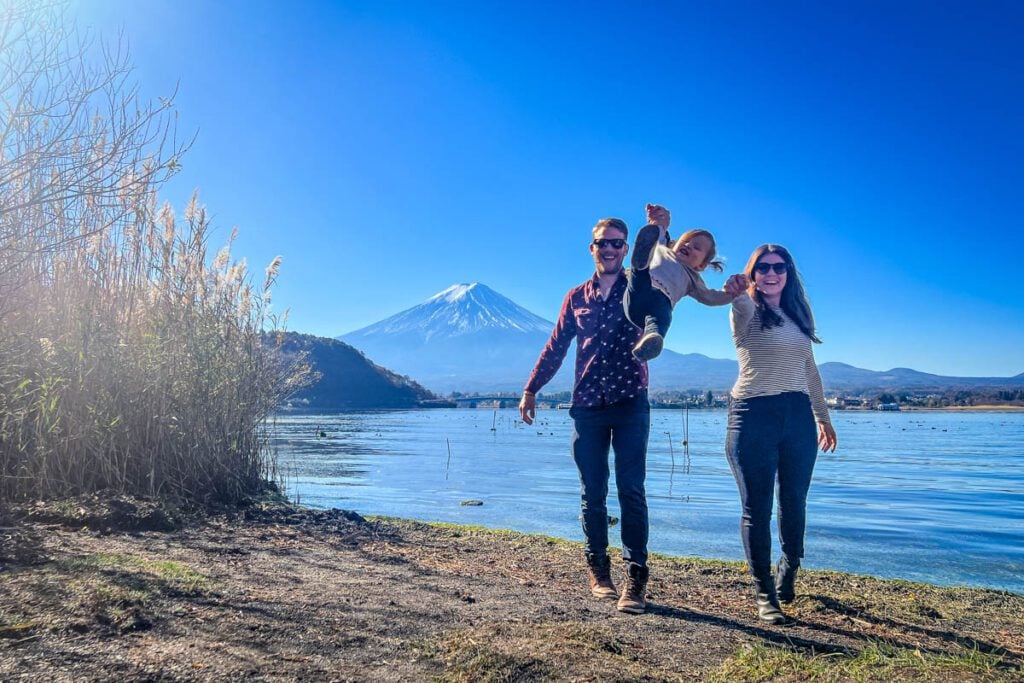
Mount Fuji should definitely be on your Japan itinerary; the question is, what is the best way to visit the magnificent peak?
The biggest advantage of a Mount Fuji day trip from Tokyo is that you can monitor the real-time forecast, look at the live cams, and plan a last-minute day trip when you have the best chances of visibility (as long as tours/rental cars/trains aren’t sold out).
That said, we highly recommend staying near Mount Fuji if you have the time.
For one thing, you’ll have more chances to see the mountain in case you get unlucky with the weather. Plus, there are lots of unique accommodations, onsens, and other things to do in the area that you wouldn’t be able to do on a day trip.
Stay at a traditional ryokan in Hakone and enjoy a relaxing soak in an onsen as stars twinkle overhead. Alternatively, Kawaguchiko has a ton of really cool glamping opportunities, like this one we personally stayed at (and loved!).
However, with an overwhelming number of things to do and beautiful places to see in Japan, lots of people will only have a day or so to spend in the Fujisan area. So without further ado, here are our recommendations for a perfect Mount Fuji day trip from Tokyo!
Day trip #1: Hakone Free Pass
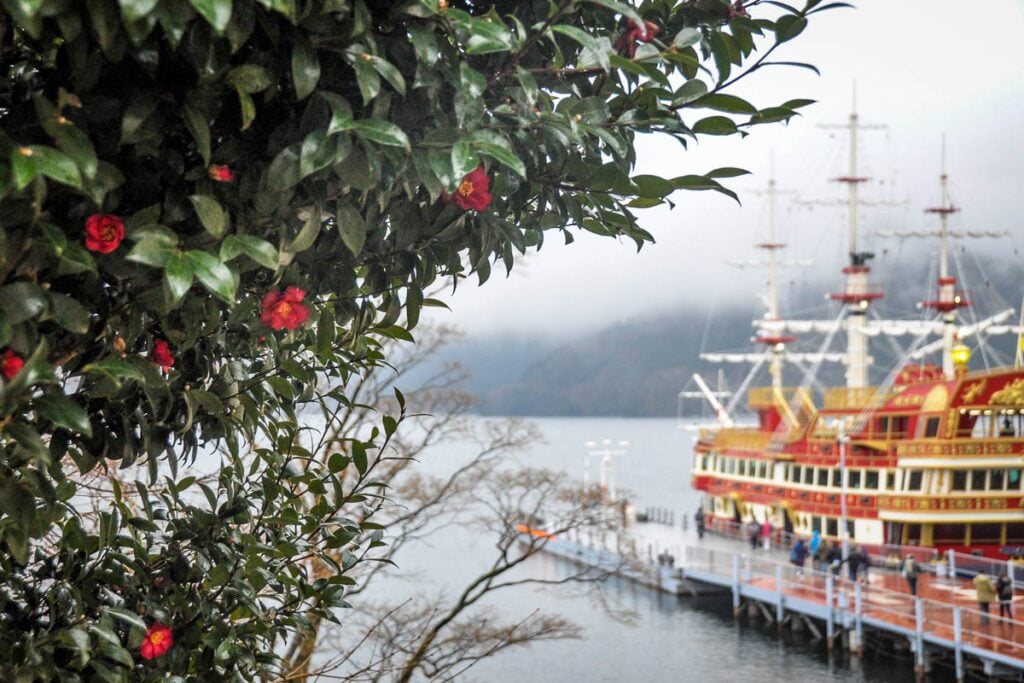
Nestled in the mountains on the shores of Lake Ashinoko, Hakone is a renowned hot spring destination and one of the most popular places to view Mount Fuji.
So popular, in fact, that the town basically has tourism down to a science in the form of the Hakone Free Pass.
Okay, so the pass is not “free” – it costs around $42-45 USD for a 2-day or 3-day pass. Note that single-day passes are not available, so if you needed an excuse to extend your trip to Hakone, you’ve found it!
The pass grants you unlimited travel on 5 different modes of transportation in Hakone, including buses, local trains, a cable car, a ropeway, and even a boat cruise. These are laid out in an easy-to-follow loop that takes you around the most famous attractions in Hakone.
Pros:
- This route is specifically designed for tourists to see the top sights around Hakone.
- The pass also gets you discounts at a number of restaurants, shops, and accommodations in the area.
Cons:
- Doing this as a day trip makes for a tight itinerary.
- You won’t be able to get off the beaten path much, and the main attractions are pretty touristy and very crowded.
How to get the Hakone Free Pass
You can purchase the Hakone Free Pass online in advance and pick it up at Shinjuku Station in Tokyo, or you can buy it in-person.
We recommend you pick up your pass a day or two beforehand, as the queue can get pretty long and you’ll want to start your day trip as early as possible.
How to get there
You should plan to arrive in Hakone and start the loop around 9 a.m. to avoid the crowds as much as possible.
With your Hakone Free Pass in hand, there are two trains you can take from Shinjuku to Odawara Station:
- The Odakyu Line takes about 1.5 hours and is included in the Hakone Free Pass
- The Romancecar Limited Express takes about 1 hour 12 minutes and costs an extra ¥1,910 (about $13 USD)
Then from Odawara, it’s a 20-minute train ride to Hakone-Yumoto Station (included in the pass), where you’ll start your sightseeing loop.
While most people go counter-clockwise, we’ve heard that doing the opposite can help you avoid some crowds; so this itinerary follows the loop in a clockwise direction.
1. See the floating torii gate at Hakone Shrine
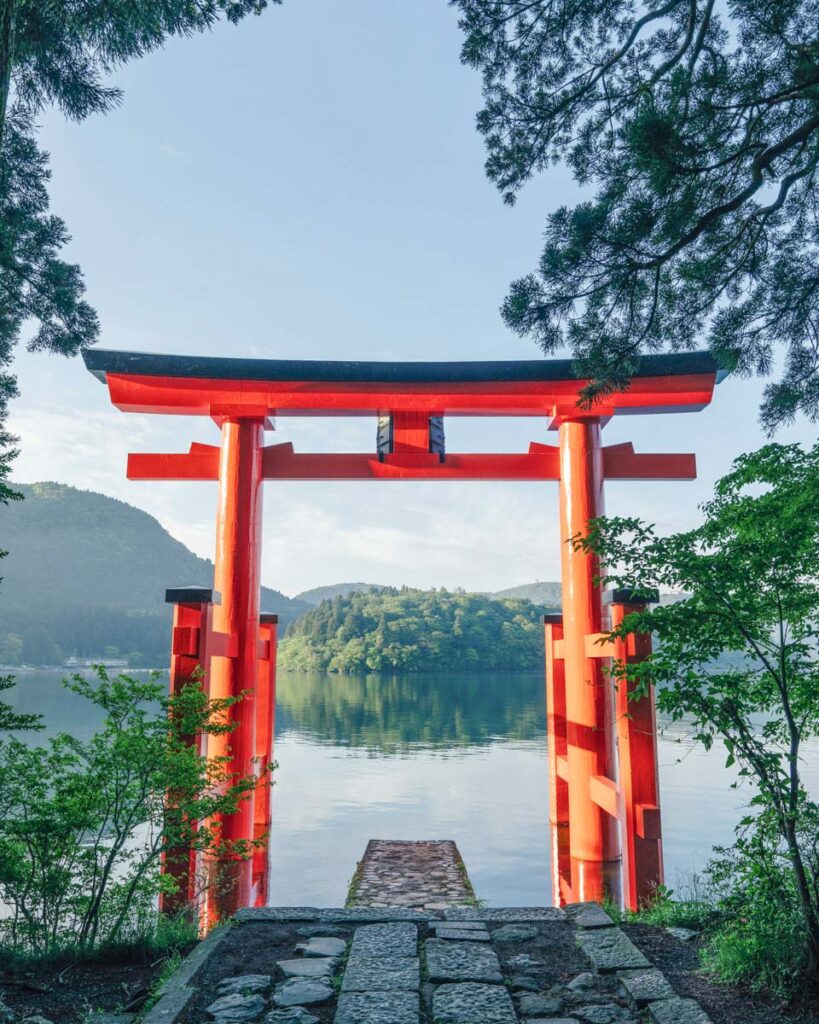
Hooray, you’ve arrived in Hakone! Hop on the Tozan Bus to Moto-Hakone pier (35 minutes). From here, it’s a short 5-10 minute walk along the lakeshore to your first stop of the day.
Hakone-jinja Shrine is the region’s most famous Shinto shrine, recognized by its iconic vermillion torii gate that stands within Lake Ashi. Known as Heiwa no Torii or “Gate of Peace”, the water gently lapping around the torii is a sight to behold.
But the rest of Hakone Shrine is not to be overlooked. Follow the beckoning torii gates into the towering 800-year-old cedars and climb the lantern-lined steps to the main shrine buildings hidden deep within the forest.
If you can peel yourself away from this peaceful setting, retrace your steps back to Moto-Hakone pier for the next leg of your journey.
2. Cruise Lake Ashi on a pirate ship

Yep, you read that correctly – included in the Hakone Free Pass is a sightseeing cruise on Lake Ashi in an elaborately-designed pirate ship.
Cheesy? Yes. Touristy? Also yes. But hey, it’s included in the pass, so climb aboard and enjoy scenic views from the water.
This is also where you’ll get that postcard-worthy shot of the floating red torii gate with Mount Fuji in the background, so have your camera ready!
3. Get a bird’s-eye view from the Hakone Ropeway

Disembark at Tōgendai Port and transfer onto the Hakone Ropeway.
Enjoy panoramic views of both Mount Fuji and Lake Ashinoko as your gondola steadily climbs higher and higher.
It takes about 15 minutes to reach the first stop at Ubako Station, then another 15 minutes to your next destination: Owakudani.
4. Eat the famous Owakudani black eggs

On arrival at Owakudani Station, head to Kurotamago House for a unique foodie experience you can’t have anywhere else: the famous black egg.
The eggs are boiled for an hour in local hot springs, whose waters are naturally heated by geothermal activity to a scalding 80° Celsius (176° Fahrenheit).
A chemical reaction occurs between the iron-coated eggshell and the hydrogen sulfide in the water, turning the shells jet-black. (P.s. The inside of the egg is totally normal – only the shells are black.)
Eating the black egg is a novel experience, but there’s another reason they’re so popular… Legend says that eating one will add 7 years to your life. We’ll see!
You can buy a bag of 5 eggs for ¥500 at Kurotamago House, along with a myriad of other black-egg-themed sweets and souvenirs.
Fun Fact: The eggs even have their own little ropeway to transport them from the hot spring to the store. How cute is that?!
5. Explore a volcanic valley

Now that you’ve had your fill of eggs, it’s time to explore one of Hakone’s most famous sights: the active volcanic zone of Owakudani.
With a name meaning “Great Boiling Valley”, Owakudani is a hotbed (pun intended) for geothermal activity. Sulfur vents spew plumes of white smoke into the air over the barren valley, creating an otherworldly landscape.
A short 10-minute walk from the ropeway station will bring you to the main volcanic zone, where you can see steam vents and bubbling hot springs up-close. On a clear day, you can even see Mount Fuji.
After taking in the scenery from the ground, hop back on the ropeway heading towards Sounzan Station. Enjoy breathtaking views from above as you soar 130 meters (436 feet) over the valley.
6. Discover the Hakone Open Air Museum

From Sounzan, take the Hakone Cable Car to Gora Station, then ride the train 1 stop (4 minutes) or walk 15 minutes to the Hakone Open Air Museum.
In Japan’s oldest outdoor museum, the natural environment is the setting of sculptures and art installations, including works from world-renowned artists like Picasso and Rodin.
You could easily lose yourself in the harmonious blend of art and nature for hours. If you’re following this itinerary as a single-day trip, you likely won’t be able to spend much time here.
- Entry fee: ¥1,400 (about $10 USD) with the Hakone Free Pass discount (¥1,600 without)
- Hours: 9 a.m. – 5 p.m. daily
7. Ride the scenic Hakone Tozan Railway
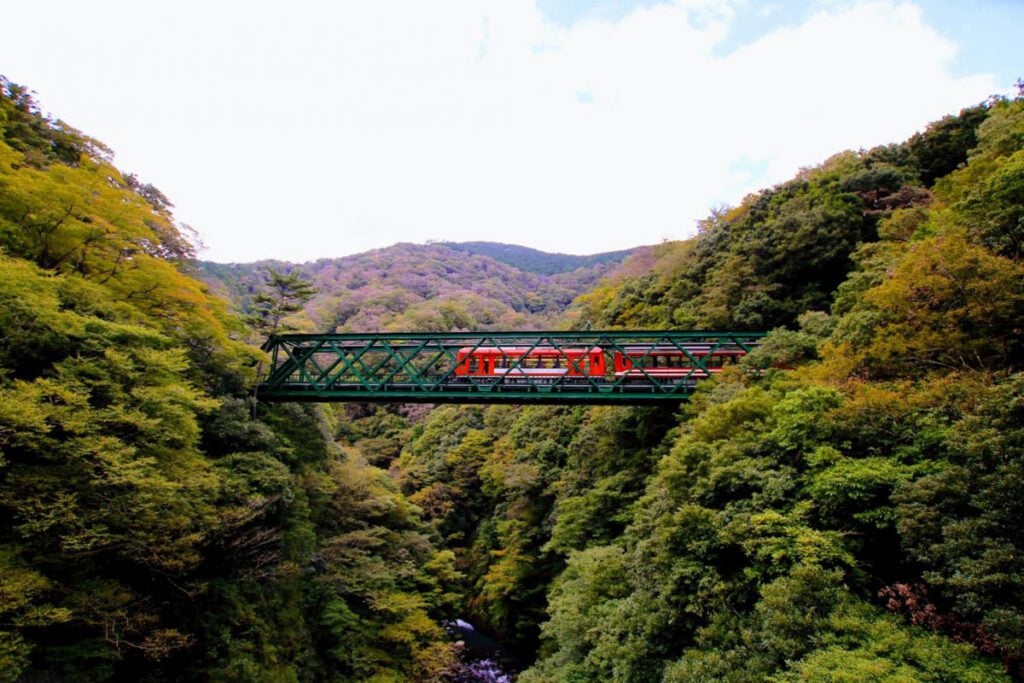
More than just a means of transportation, the Hakone Tozan Railway is Japan’s oldest mountain railway, and an experience in itself.
The ride from Gora Station to Hakone-Yumoto takes about 35 minutes as the train snakes its way through forested valleys, over high alpine bridges, and through deep mountain tunnels.
The ride is especially picturesque in late-June to early-July, when thousands of hydrangeas bloom alongside the tracks. Though if seeing Mount Fuji is your goal, keep in mind that this is statistically the worst time to view the peak.
Return to Shinjuku from Hakone-Yumoto Station the same way you came in. If you’re not too exhausted from your busy day trip, check out our favorite things to do in Tokyo at night.
Day trip #2: Self-drive to Kawaguchiko
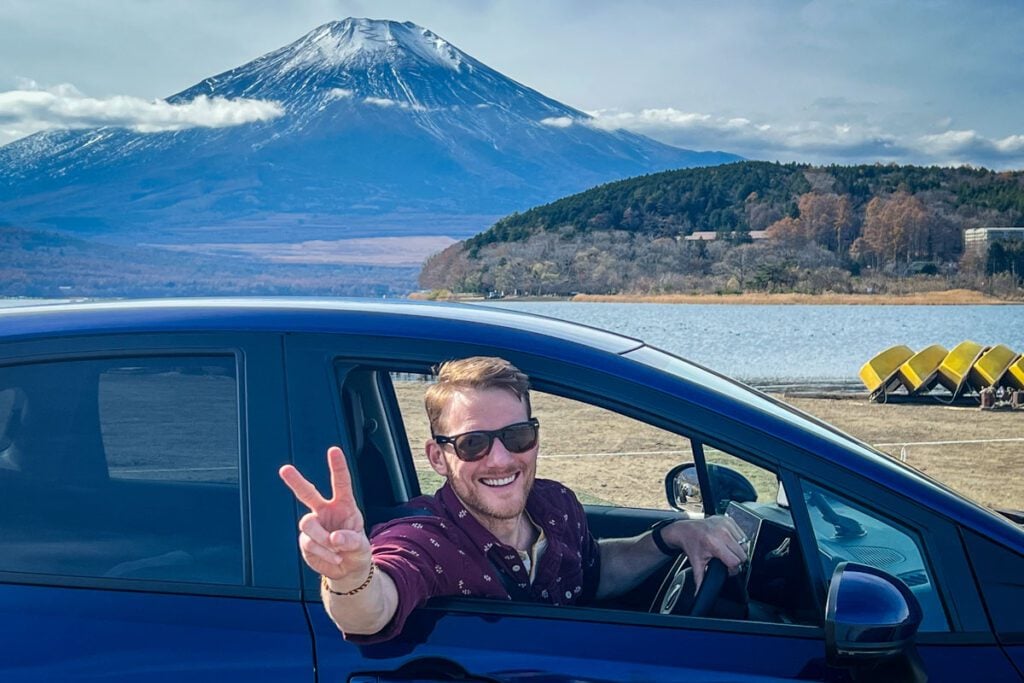
The most accessible of the Fuji Five Lakes, Lake Kawaguchi is undoubtedly one of the most popular places to view and photograph Mount Fuji. With multiple iconic viewpoints, must-see attractions, and hidden gems in the area, Kawaguchiko makes a great choice for a Fuji day trip from Tokyo.
First things first: for this itinerary, you will need a rental car.
We’ve looked into the logistics of visiting Kawaguchiko from Tokyo via public transportation, and it’s far too time-consuming and involves too much walking to be doable as a day trip.
We personally loved having our own wheels during our most recent trip to Japan, and we think you will, too!
Pros:
- Self-driving gives you much more flexibility to travel at your own pace and choose the sights you most want to see.
- Driving in Kawaguchiko is easy. The roads are good, there isn’t a lot of congestion, and there’s ample parking available.
Cons:
- Some people might be nervous about driving in a foreign country. Our guide to renting a car in Japan should help ease your worries!
How to get there
You can pick up your rental car at just about any major train station in Tokyo. We personally picked ours up at Shinjuku Station and found it super easy.
From Shinjuku Station, follow these directions to Arakurayama Sengen Park. The distance is just under 100 km (62 miles) and the drive should take about 1 hour and 15-30 minutes, depending on traffic.
1. Photograph Mt. Fuji with Chureito Pagoda

Located within Arakurayama Sengen Park, Chureito Pagoda is celebrated as one of the best places to view and photograph Mount Fuji. By making this your first stop, you can avoid some of the crowds and capture the best lighting in the early morning.
Arrive as early as possible and secure parking at this free lot across from the park.
Opposite the parking lot, a set of lantern-lined stone steps leads up past the main buildings of Arakura Fuji Sengen Shrine. You can stop to check them out on your way back down – now it’s time to get your booty up to the viewpoint before it gets too crowded!
In total, there are 398 steps, though there is also a walking path if you prefer a gentler slope. At the top, you’ll be rewarded with arguably one of the most iconic views in Japan: the red 5-tiered Chureito Pagoda framed against the backdrop of Mount Fuji.
This is where you get that postcard-perfect shot – you know the one I’m talking about!
You’ll find several other viewpoints at the top of the hill, as well as a public toilet and some wooded hiking trails. You can do some exploring, but keep an eye on the time.
2. Ride the ropeway to panoramic views
Next, drive 13 minutes to the Mt. Fuji Panoramic Ropeway. This nearby lot is free (and actually has a nice view of the lake as an added bonus).
It takes only 3 minutes for the gondola to ascend 400 meters (1,312 feet) to Kawaguchiko Tenjozan Park. Stand near the back of the car to enjoy the view going up.
At the top of the ropeway is an observation deck offering breathtaking panoramas of Mount Fuji and Lake Kawaguchiko. Spend a few minutes enjoying the view before heading back down on the ropeway.
Wondering about all the rabbit and raccoon motifs? This mountain is the setting of a famous Japanese folktale about a rabbit and a tanuki (Japanese raccoon dog).
- Ropeway fee: ¥900 round-trip (about $6 USD)
- Hours: 9 a.m. – 4 p.m. weekdays, 9 a.m. – 5 p.m. weekends and holidays
- Google Maps location
3. Frame Mt. Fuji in a red torii gate
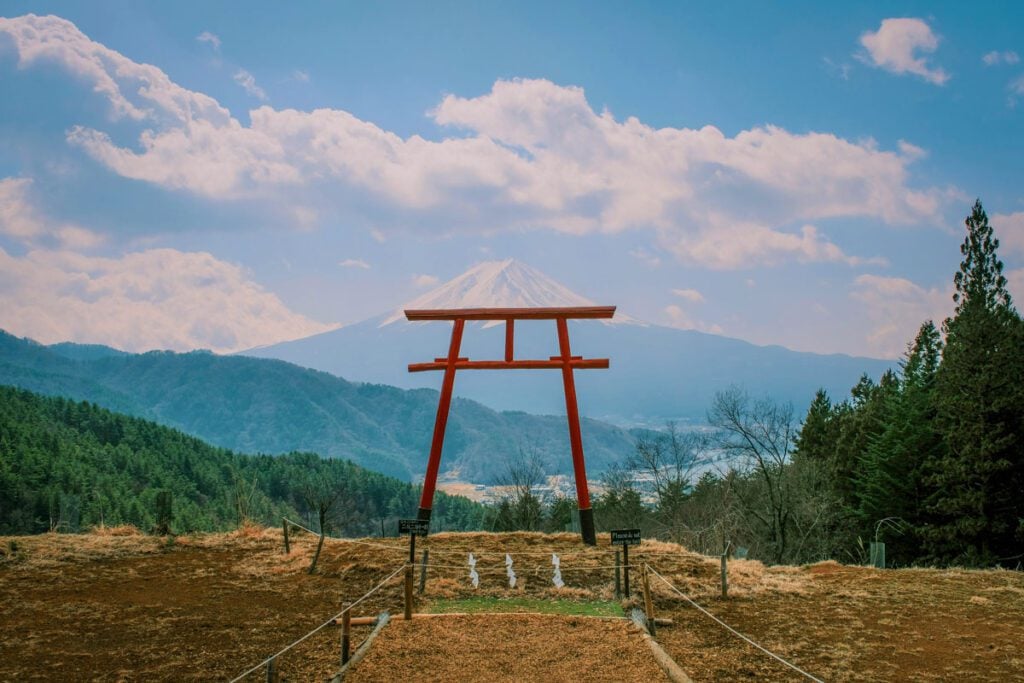
Drive another 13 minutes to Tenku no torii.
At this famous site, a red torii gate stands perched on the hillside, perfectly framing the snow-capped peak of Mount Fuji.
To approach the torii for that sought-after shot, you’ll need to pay a fee of ¥100 (about 68 cents US) to take photos with your phone, or ¥500 to use a camera. Tripods are prohibited.
Each group is limited to 3 minutes in front of the torii to take pictures. There’s usually a line, and we’ve heard the wait can be an hour or more during peak times.
Otherwise, there are plenty of fantastic views you can enjoy for free from the hilltop.
It is possible to drive up to Tenku no torii, but the road is narrow and parking can be dangerous as there is very little space and no designated lot. Alternatively, it’s about a 30-minute uphill walk from Kawaguchi Asama Shrine.
Another 10-15 minute walk up the mountain past Tenku no torii, there’s another red torii gate that stands next to a waterfall. This picturesque spot is much less busy and feels more like a hidden gem.
Drive back into town, about 4-5 minutes. The next few stops on this itinerary are within walking distance of each other, so we recommend parking and enjoying the sights on foot. This free lot is in a good location and there’s a scenic walking path along the lake.
4. Stop at this free viewpoint
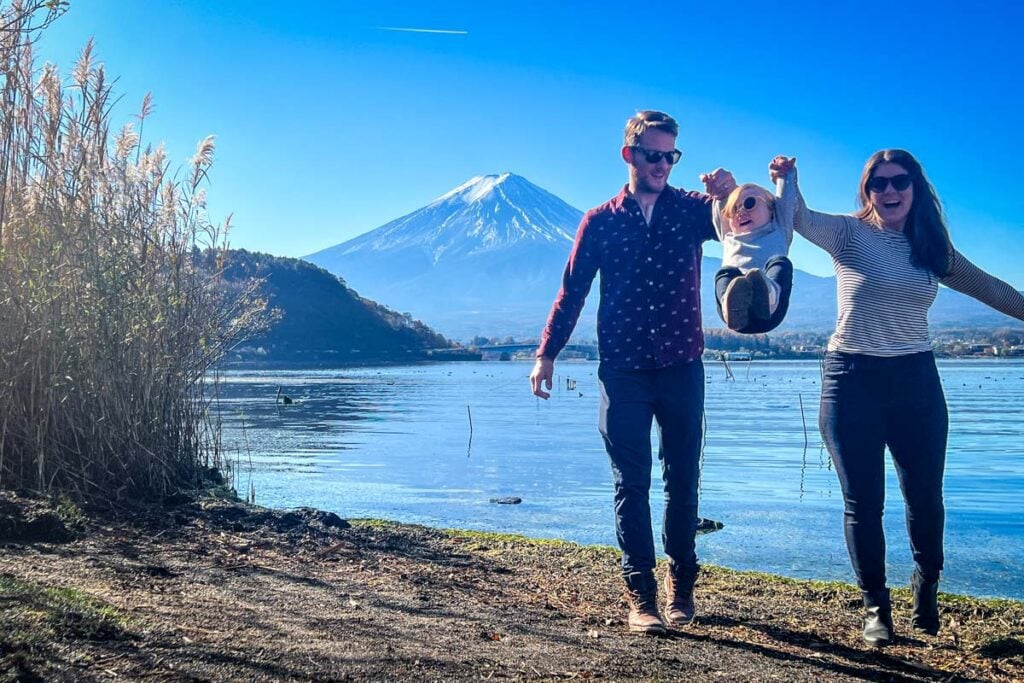
While exploring Kawaguchiko, we stopped at any viewpoint we saw that wasn’t too crowded.
This spot very close to the Music Forest Museum has unobstructed views of Mount Fuji across the lake where we were able to get some great shots!
5. Slurp hoto in a noodle shop

If your tummy is starting to rumble, now is a great time to get some lunch. The local specialty, hoto (sometimes spelled houtou), is sure to satisfy your craving for carbs.
Hoto is a regional stew famous in Yamanashi Prefecture. It’s made with thick, hearty noodles and vegetables (typically pumpkin) in a piping-hot miso-based broth. Some restaurants have meat options as well.
You can walk to any of these restaurants for a steaming bowl of hoto:
- Momijitei-Hoto: homey restaurant offering pumpkin, beef, or mushroom hoto à la carte or in a combo with tempura
- Houtou Fudou Kawaguchiko North Main Shop: limited menu with a special in-house spice mix you can add to your hoto
- KANJYUKUYA: farm-to-table restaurant with a seasonal menu in a renovated 120-year-old traditional house
6. Stroll the Momiji Corridor (in autumn)
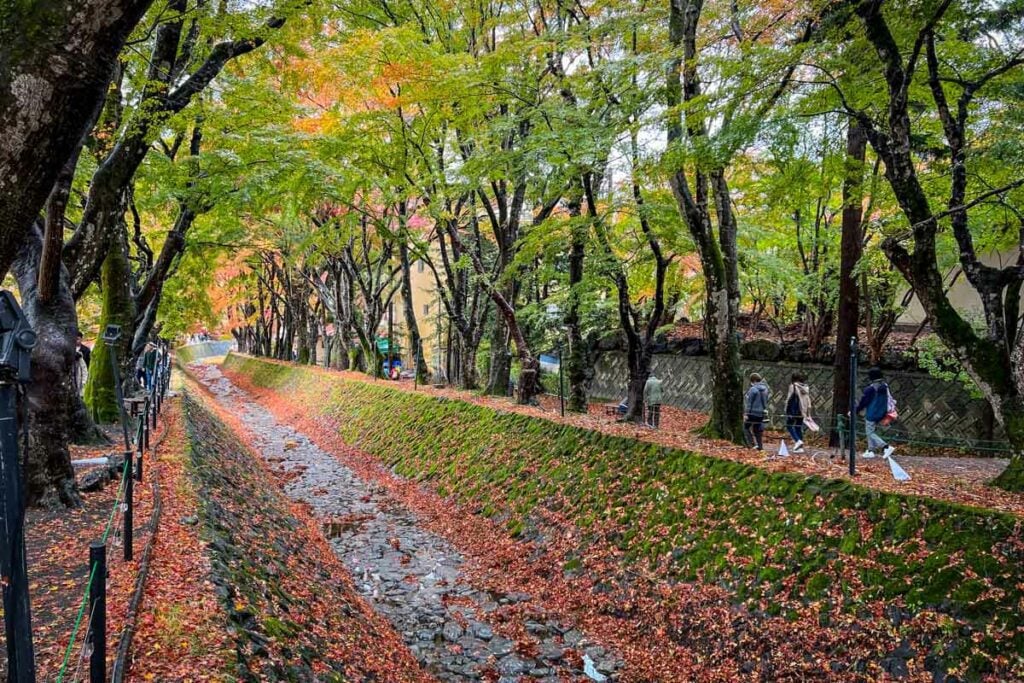
If you’re visiting Kawaguchiko in autumn, you won’t want to miss one of the best places to photograph Japan’s famous fall foliage: the Momiji Corridor.
For a stretch of about 150 meters (almost 500 feet), Japanese maple trees line the canal, their branches closing overhead to create a tunnel-like effect.
When autumn peaks around early- to mid-November, these trees display vivid shades of crimson, gold, and orange. Meanwhile, fallen leaves carpet the bottom of the dry canal to complete the 360-degree tunnel of fall colors.
Good to know: This location is different from the Momiji Tunnel, which is a popular spot to photograph Mount Fuji with red Japanese maples in the foreground.
7. Visit the Kubota Itchiku Art Museum

Tucked in the wooded foothills of Mt. Kurodake, just a 5-minute walk from the Momiji Corridor, the Kubota Itchiku Art Museum is a must-see if you have the time.
The museum is the legacy of the celebrated textile artist Kubota Itchiku. Kubota is credited with reviving tsujigahana, a method of silk-dyeing used during the Muromachi Period (1333-1573), and the museum houses his colorful collection of intricately-dyed kimonos.
Not only did Kubota supply the gallery, he also designed the museum itself, as well as its expansive gardens. With Gaudi-inspired architecture, cypress timber, and Okinawan coral and limestone, the buildings blend harmoniously with the natural surroundings.
The Japanese gardens are stunning and well worth exploring. Before you leave, be sure to check out the teahouse, located in Kubota’s former workshop.
We were lucky to be seated right in front of the windows, which look out on a tranquil pond surrounded by mossy rocks and maple trees. We visited on a drizzly day and watched raindrops ripple the water’s surface while we sipped our tea. It was magical.
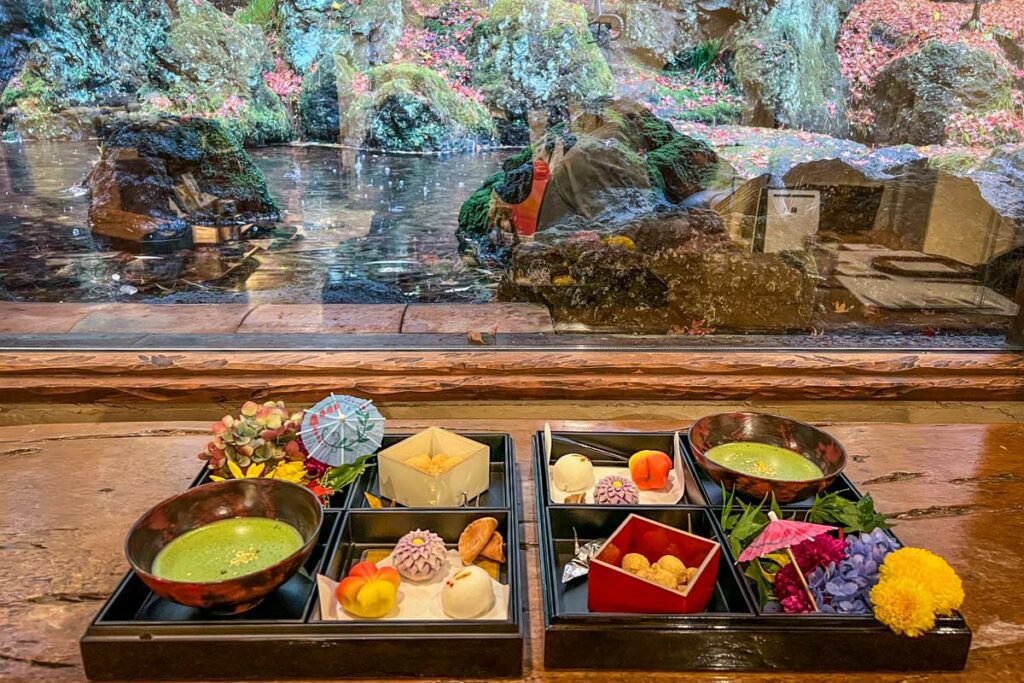
And as if the setting wasn’t perfect enough, the matcha set was the prettiest, most Instagram-worthy I have ever seen. I actually took 46 photos of the tea set alone – no joke. It was a work of art in itself.
- Entry fee: ¥1,300 (~$8.78 USD)
- Hours: 9:30 a.m. – 5:30 p.m. April to November, 10 a.m. – 4:30 p.m. December through March; closed on Tuesdays (except October and November)
- Google Maps location
8. Get an iconic view from Oishi Park
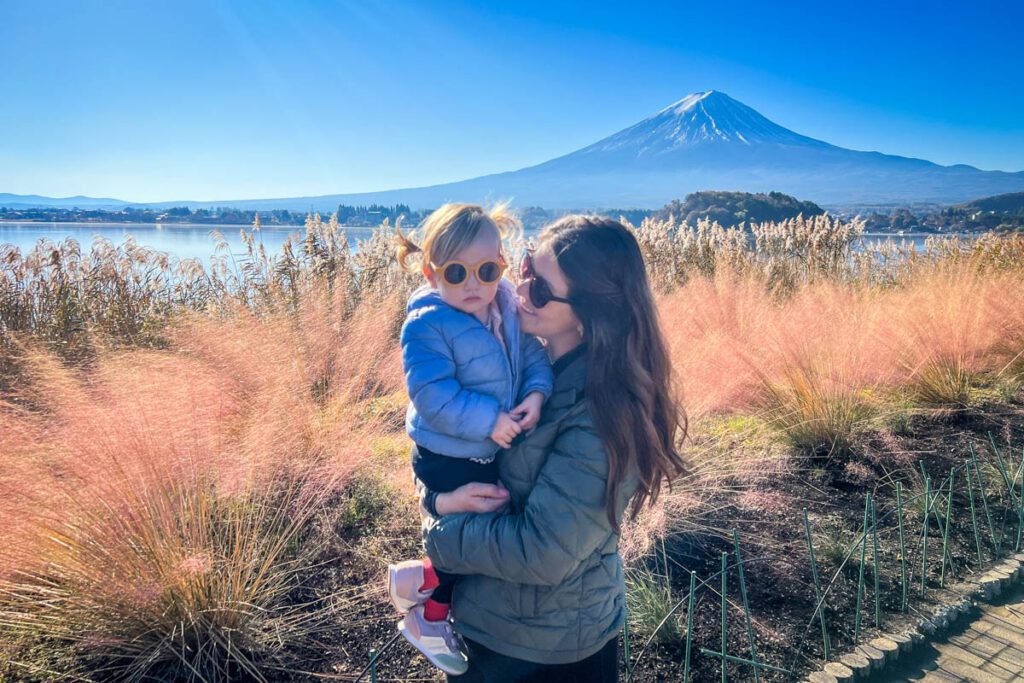
Head back to your car and drive to Oishi Park on the northern shore of Lake Kawaguchiko.
Expect it to be crowded, as this is one of the most popular places to photograph Mount Fuji – and for good reason.
The view is spectacular, with colorful flowers stretching to the edge of the glimmering lake while Mount Fuji towers above.
Known as “Flower Street”, the 350-meter (1,148-foot) path through Oishi Park is bordered on both sides by gardens that display seasonal blooms. The lavender fields in June – July are popular, as well as the rounded kochia bushes that turn bright red in the fall.
Day trip #3: Guided tour from Tokyo

If you’re still feeling overwhelmed about planning a day trip to Mount Fuji, then joining a tour might be the way to go.
With itineraries ranging from 10-12 hours, these guided day trips are long but effective. This is by far the simplest way to ensure you see some of the top attractions in the Fujisan area and still make it back to your Tokyo hotel by bedtime.
Pros:
- Everything is planned for you, so you don’t need to lift a finger.
- These tours are highly organized to maximize your time.
Cons:
- You won’t be able to explore at your own pace.
- You’ll be traveling with a large group. (You could see this as a pro – hello, new friends!)
From Tokyo: Mt. Fuji Full-Day Sightseeing Trip

This affordable tour includes a round-trip bus from Tokyo and stops at Lake Kawaguchiko, Arakurayama Sengen Park, Oshino Hakkai, and Mt. Fuji 5th Station (weather permitting).
From Tokyo: Mt. Fuji 5th Station & Lake Kawaguchi Bus Tour
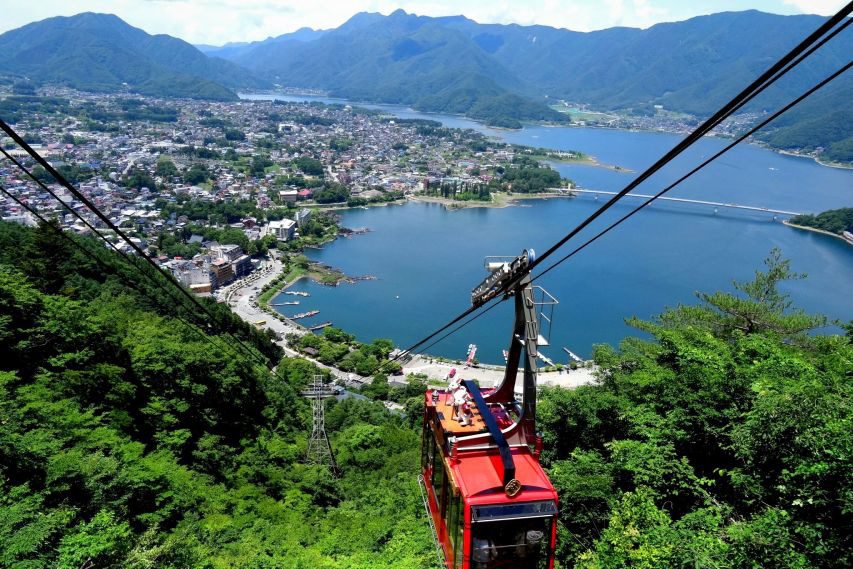
One the most highly-rated guided day trips from Tokyo to Mount Fuji, this tour includes a ride on the Panoramic Ropeway cable car and a scenic boat cruise on Lake Kawaguchiko. You can add lunch at FujiQ Highland for an additional fee.
From Tokyo: Guided Day Trip to Hakone, Owakudani & Mt. Fuji

On this popular tour, you’ll cruise Lake Ashi aboard a pirate ship, ride the Hakone Ropeway cable car, and explore Owakudani, an active volcanic landscape of sulfur fumes and hot springs.
Weather permitting, you’ll end your tour at Mt. Fuji 5th Station and Oshino Hakkai, a UNESCO World Heritage Site.
This tour offers an optional lunch for an additional fee.
Facts about Mount Fuji

Now that you know your options for a day trip to Mt. Fuji from Tokyo, we thought we’d pump you up with some fun facts about Japan’s most famous mountain. Get ready to have your mind blown!
Essential Facts
- At 3,776 meters (12,388.5 feet), Mount Fuji is Japan’s highest peak. It is also the most climbed mountain in the country, as well as the most depicted in art, poetry, and music.
- Located on the island of Honshu, the mountain straddles Yamanashi and Shizuoka prefectures. It’s the focal point of Fuji-Hakone-Izu National Park and a UNESCO World Heritage Site.
- At its base, Mt. Fuji has a circumference of about 78 miles (125 km).
Scientific Facts

- Mount Fuji is considered an active volcano, even though it hasn’t erupted since the early 1700s. It’s even part of the infamous Ring of Fire, which sees the most volcanic eruptions and earthquakes in the world.
- It’s technically 3 volcanoes stacked on top of each other: Komitake on the bottom, Ko Fuji (Old Fuji) in the middle, and Shin Fuji (New Fuji) on top.
- Mt. Fuji supports a surprising amount of biodiversity, including more than 30 species of mammals such as Asiatic black bears, wild boar, and the Japanese serow.
Historical Facts
- The first person ever recorded to have summited Mount Fuji was a Buddhist monk in 663 AD.
- Until the late 1800s, women were forbidden from climbing Mount Fuji. Tatsu Takayama became the first woman to summit the mountain in 1832, before women were allowed.
- Sir Rutherford Alcock famously became the first foreigner known to have made the climb in 1860.
Cultural Facts
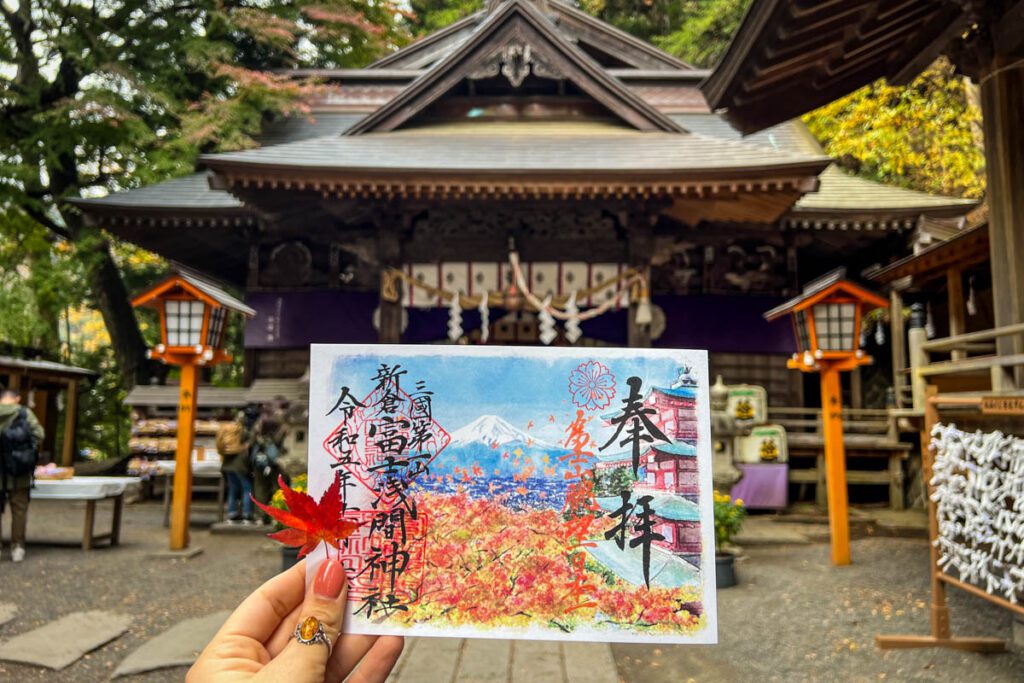
- Mt. Fuji is one of Japan’s three sacred mountains, along with Mount Haku and Mount Tateyama.
- Both major religions in Japan (Shinto and Buddhism) worship the natural symbol of Mount Fuji as a god, whereas its volcanic activity symbolizes earth, sky, and fire.
- Located at the peak, Fujisan Hongu Sengen Taisha is the highest shrine in Japan.
Fun Facts
- You can send a postcard that’s actually postmarked from the famed peak, thanks to the Mount Fuji Summit Post Office! Located—you guessed it—on top of the mountain, the office is open from 6 a.m. to 2 p.m. in the summer months.
- If you forgot to pick up a postcard, no worries – you can send off a quick email because there is WIFI at the summit!
- Hundreds of thousands of people climb Mount Fuji every year.
- The Japanese thing to do is to hike up in the dark and arrive at the peak to watch the sunrise. Poetically, the Japanese even have a word for this exact experience: goraiko (御来光), or “the Great Sunrise at the top of Mt. Fuji”.
Other things to do nearby Mount Fuji if you have the time

If you decide to extend your day trip and spend more time around Mount Fuji, you’ll find endless things to do in the area. Here are a few recommendations:
Hakone

- Stay at one of the many traditional Japanese ryokan. Tip: Look for one that offers a discount with your Hakone Free Pass.
- Enjoy a relaxing soak at Tenzan Onsen, a hot spring village with indoor and outdoor baths in a tranquil natural setting.
- Stroll through a sea of swaying pampas at Sengokuhara Susuki Grass Fields, a dreamy landscape that changes color with the seasons.
- Hike to Hiryu Falls, a two-tiered cascade tucked away in a lush forest.
Kawaguchiko

- Go glamping in the Fuji Five Lakes area. We loved our stay at this glampground, which has an incredible view of Mount Fuji.
- Discover the Kawaguchiko Music Forest, a museum that houses antique music boxes and mechanical instruments within beautiful European-style gardens.
- Make your own jam at the Kawaguchiko Natural Living Center in Oishi Park. The center also offers a couple of cafes, a handful of shops, and fruit picking in the summer.
- Get ice cream at Gelateria Angela, a shop known for unique flavors such as chili pepper dark chocolate, charcoal vanilla, and parmigiano reggiano.
Best time to visit Mount Fuji

One thing many first-time visitors to Japan may not realize (including us in 2015!) is that Mount Fuji is notoriously shy. There is much of the year where she will stay cloaked behind clouds and haze, only peeking through on rare occasions.
Statistically speaking, you will have the best chance of seeing Mount Fuji between the months of October and February. Conversely, the worst chance of visibility is in July.
That said, nothing is promised when it comes to weather…
Case in point: our first trip to Japan was early February, when we should have had a good chance of seeing Mount Fuji – but all we saw was a wall of white clouds. On the other hand, we’ve known people who have seen Fuji peek out during July and August, supposedly bad months for viewing the mountain.
Our thoughts: We think Mount Fuji is particularly photogenic in autumn, with fall foliage all around and a good chance of seeing the peak covered in a blanket of white after a snow storm.
When to arrive
We recommend starting your day trip to Mount Fuji from Tokyo as early as possible so that you have time to see everything on this itinerary and not feel rushed.
Psst! For more info, check out our guides to the best time to visit Japan and the best time to visit Tokyo.
What to pack for a day trip to Mount Fuji
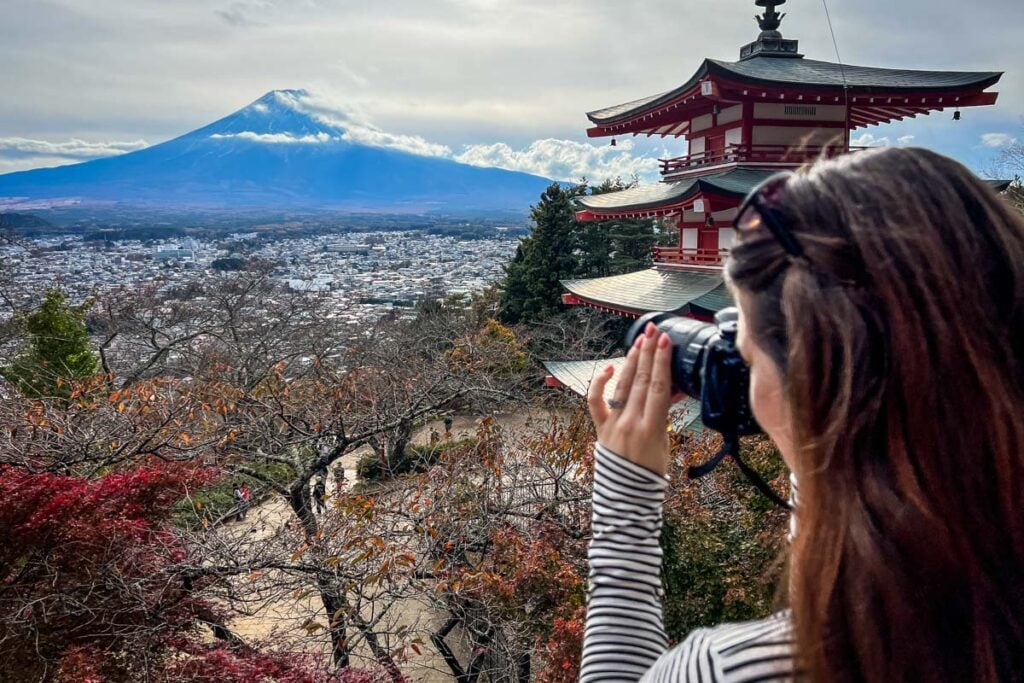
What you’ll need to bring to Mount Fuji will depend on how you get there, when you visit, and what you plan to do. Here are a few universal day trip essentials to get you started:
- Daypack: Having a small backpack will be a good way to carry your belongings.
- Photo equipment: Though smartphones these days have great cameras, this area is world-renowned for photography, so you might want to bring out the big guns.
- Comfortable shoes: Wearing comfy shoes is a must, as you’ll be clocking in lots of steps.
Be sure to check out these super handy guides full of packing hacks and tips for traveling in Japan that you won’t find anywhere else:
- Our Japan packing guide lists all the essentials (many of which you might not think about), as well as what you should NOT pack for a trip to Japan.
- This article on what to wear in Japan will help you create a perfect capsule wardrobe for every season and let you in on some cultural taboos so you can be sure to dress appropriately.
- With this FREE Japan packing list PDF download, we’ll send checklists straight to your inbox for everything from clothing and toiletries (for both women and men!) to what shoes to pack and extra stuff you may want to have on-hand just in case. Click the image below to get your free copy!
Mount Fuji FAQs

Still have questions about visiting Mount Fuji? We’ve answered some common questions below. If you don’t see what you’re looking for, ask us in the comment section at the end of this article and we will do our best to get back to you!
Can Mt. Fuji be a day trip from Tokyo?
The short answer is yes, you can visit Mount Fuji as a day trip from Tokyo.
However, we highly recommend spending more time in the area if you can manage.
There are lots of unique accommodations, from onsen ryokans in Hakone to glamping in Kawaguchiko. Plus, you’ll have more chances to see the mountain in case you get unlucky with the weather!
Is a Mount Fuji day trip worth it?

This kind of depends on two things: the weather, and your attitude.
If you get lucky with clear skies, then taking a day trip to Mount Fuji is one of the best things you can do in Japan, hands-down.
But if the notoriously shy mountain is hiding in the clouds… well, the word disappointed didn’t seem strong enough when this happened to us on our first trip to Japan.
My best advice would be to manage your expectations, and to have a couple of ideas for fun backup activities in case Mount Fuji is not visible. That way, you can still enjoy the area even if you don’t get to see the mountain. Trust me, there’s a lot to love about this part of Japan!
What is the best way to see Mount Fuji?
There are a few ways to go about catching a glimpse of the famous Mount Fuji.
The best choice for yourself will depend on several factors, such as your travel style, how much time you have, and whether or not you’re renting a car in Japan.
Can I use the JR Pass to get to Mt. Fuji?
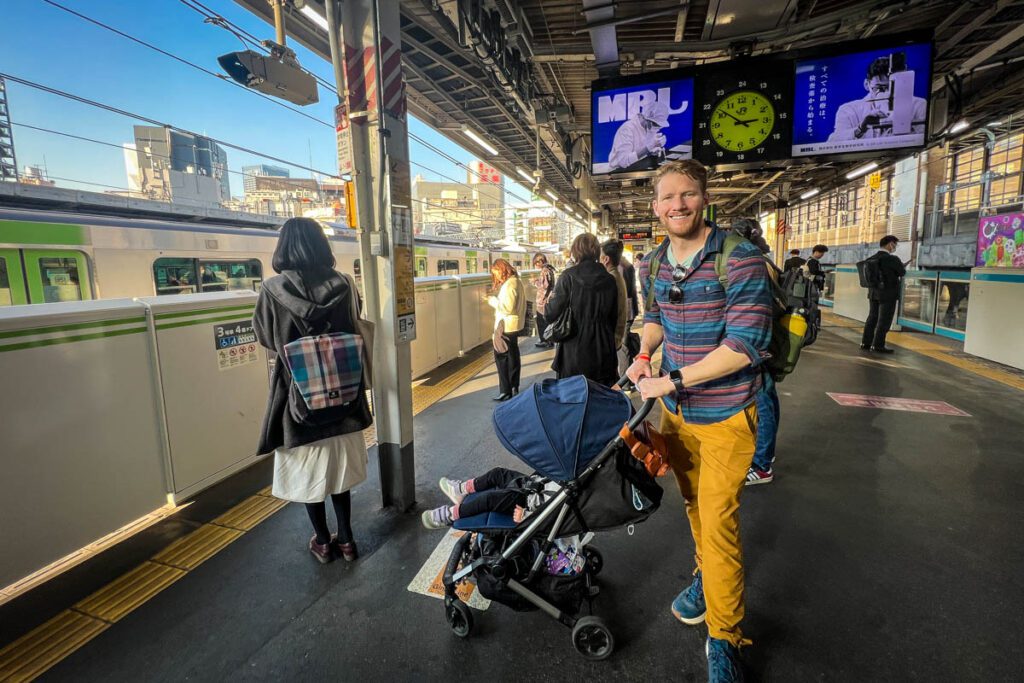
The Hakone region is not covered by the JR Pass. You’ll need to purchase the Hakone Free Pass or individual tickets for this day trip.
Psst! We have a detailed guide that answers all your questions about the Japan Rail Pass, including how to get it, how to use it, how much it costs, and whether it will be worth it for your trip.
How much is the train ticket from Tokyo to Fuji?
The Hakone Free Pass ($42-45 USD for a 2-day or 3-day pass) includes round-trip travel from Shinjuku Station to Hakone on the regular Odakyu Line, as well as 5 different modes of transportation within Hakone.
Without the pass, the same trip would only cost about $17 USD; however, you would then have to pay for all your transportation in Hakone on top of that. Not only could it end up costing more depending on what you do, but you’d also have to worry about getting individual tickets for everything.
Trust me on this one – the Hakone Free Pass is worth it!
How long is the bullet train from Tokyo to Mount Fuji?
It takes around 2 hours to get to Hakone from Shinjuku Station on the regular train, or about 80 minutes on the express train. There’s no direct Shinkansen from Tokyo to Hakone.
When did Mount Fuji last erupt?
The last confirmed eruption of Mount Fuji was recorded on December 16, 1707.
Can tourists climb Mount Fuji?

Yes, tourists are welcome to climb Mount Fuji. However, overcrowding in recent years has led the Japanese government to impose new restrictions.
Starting July 1, 2024, the number of tourists allowed to hike the mountain will be capped at 4,000 per day. Currently, the short July-to-September season sees more than 200,000 climbers (both locals and visitors) each year.
Foreign climbers will also be required under the new regulations to pay an entry fee of ¥2,000 per person (about $13.50 USD). The trails will also be supervised to ensure safe and responsible behavior among hikers.
Plan your trip to Japan
After 3 trips (and counting!), we’ve fallen head over heels for Japan—and we’ve created TONS of resources to help you plan your dream trip. Start with our Ultimate Japan Travel Guide and be sure to check out these helpful articles:
- First time? Our Japan Trip Planner walks you through everything you need to know.
- Use our Japan Rail Pass guide to determine if getting a train pass is optimal for your trip.
- Here’s our curated list of the best things to do in Japan—from iconic sights to once-in-a-lifetime experiences.
- Not sure where to go? Our Japan itinerary ideas will help you map it all out.
- Foodies, rejoice! This guide to what to eat in Japan will have you drooling before you land.
- This guide to what to wear in Japan (and what not to wear) will help you blend in.
- Use our ultimate Japan Packing List to make sure you don’t forget anything.
- Before you go, brush up on these essential Japan travel tips (including major do’s and don’ts!).
- Avoid awkward moments by brushing up on Japanese etiquette.
Still have questions? Drop us a comment—we LOVE helping travelers plan unforgettable trips to Japan!
Perfect Japan itinerary
Want the perfect itinerary planned for you?

If you don’t have a ton of time to spend planning your Japan itinerary (or you just don’t find travel planning fun), we’ve got something you might be interested in…
We created the ultimate done-for-you Japan itinerary that is packed full of all sorts of tips we’ve gathered from 3 trips to Japan as well as literally hundreds of hours of research (no exaggeration).
We have both an off-the-beaten path route as well as a classic itinerary that hits the top attractions (perfect for your first visit to Japan!).
Don’t miss your chance to grab our Japan pocket guide!
This FREE PDF download includes everything you’re going to want to pack for your Japan trip, including what NOT to bring, plus tons of insider tips!
Just enter your email and we’ll immediately send you access instructions!
Save this article on Pinterest for later!
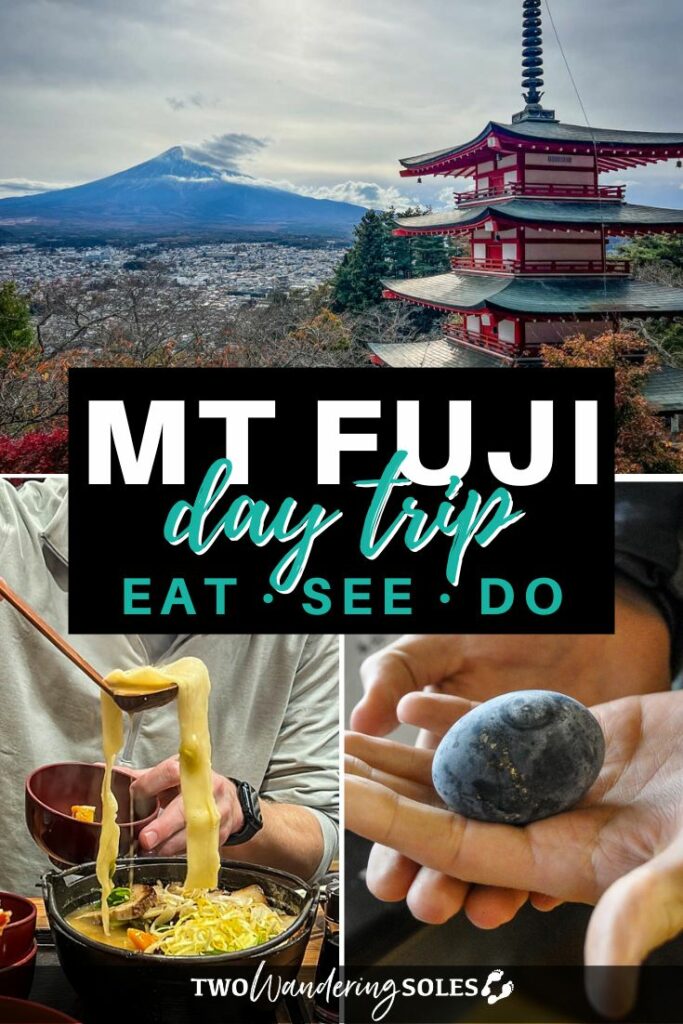
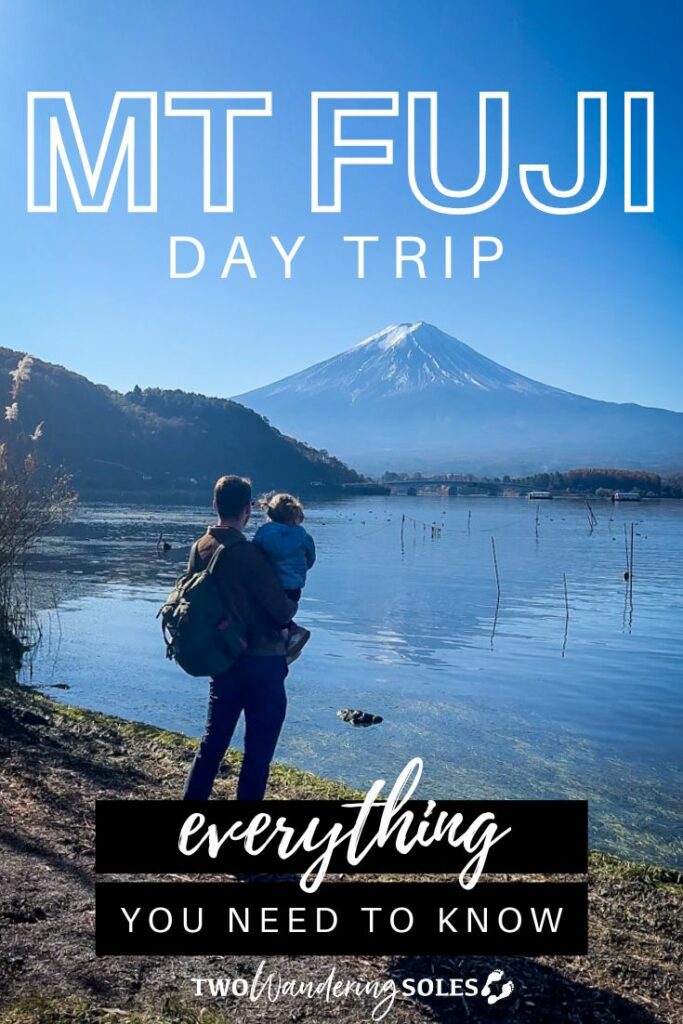
We want to hear from you!
Have you ever seen Mount Fuji in person? Do you still have questions taking a Mt. Fuji day trip after reading this article? Leave us a comment below and we’ll do our best to get back to you!

